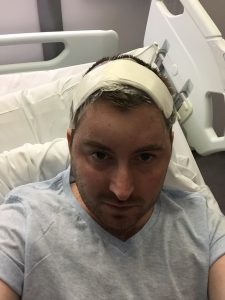Described by Danny Jones (of McFly fame) as the ‘loveliest & most upbeat and positive person despite being dealt a pretty crappy card’, the inspirational Dai Knight is recording an album about his brain cancer journey. Here he tells us why.

“On 28th January 2015, I woke up surrounded by paramedics – I was unsure why. As it turns out I’d had a massive seizure in my sleep. The only reason I know this is because I was with my new partner and for the previous 8 years I’d been sleeping on my own… looking back I’d had a lot of night time seizures over the few years leading up to this one.
Diagnosis and brain surgery
Once at the hospital I was diagnosed with a “large lesion on my left frontal lobe” – to be perfectly candid, I didn’t understand what that meant. In fact it wasn’t until I overheard someone saying “he has a brain tumour” three days later when I was being discharged that it clicked. Not sure if that makes me really stupid or just a bit naive really, but there we are. So I had surgery to remove as much of the tumour as possible. When they eventually came to speak to me after surgery they told me that it was a low grade 2 Oligodendroglioma – a word that has taken me a long, LONG time to learn how to spell! They had removed about 90% of it and no further treatment necessary. Great!

Dai, during brain tumour treatment
Back to normality and then disaster strikes once more
Eventually I was back to everyday life. Fast forward to March 2017. I went to Sainsbury’s one day to pick up a few bits, next thing I know I’m waking up on the floor with cuts and bruises all over my face, a chipped tooth, I’d bitten through my tongue and thrown my back out (turns out I face planted a fridge on my way down). I was highly confused and it didn’t hit me until I was in an ambulance on the way to A&E again that I’d had a seizure.
Over the next couple of months came more seizures, fracturing eye sockets (how can you even do that), smashing a huge hole in my nose, lots more tongue bites and back strains. About a week after a seizure I had another MRI scan. After a couple of (stressful) weeks I got the results. Regrowth. Heart – meet floor! Oddly though, the night before getting the results I’d had a dream that I needed chemo and I think that prepared me for it in a way. After some discussion we decided that 6 weeks of radiotherapy and 6 months of chemotherapy should help.
More treatment and dark times
I had my 6 weeks of radiotherapy, last seizure was the beginning of this year. However it took me 9 months to finish my course of chemotherapy because apparently my bone marrow was refusing to do it’s job properly. I was feeling worse and worse and I didn’t realise I was depressed until I got into work one day and couldn’t stop crying! Obviously they sent me home and I was rolling through every emotion under the sun. I didn’t realise how sick I actually was until I began to feel better.
Now, when I first found out I would need chemotherapy I made a deal with my friend Nick; he would finish the book he was writing and self publish and I would write and record a solo album. He’s finished his book and you can buy it on amazon (Nick Spindler: A Layman’s Guide to Space, Time, The Universe and other Unbelievable Stuff). So I had to write and record my album.
A campaign is born…
I don’t want to go small. I want to go big! I can play all the instruments myself so why not? Not being able to do this very cheaply I started a GoFundMe campaign. Within 2 weeks I’d raised over £4000. I was researching studios and just to get it recorded would cost three quarters of that, leaving me with enough for mixing and mastering. But then how would I be able to raise the money for charity? So I upped my goal to £8000!
There a number of reasons this album would be special to me. Firstly if I can do anything to help even ONE patient feel better, or feel like there is someone else out there who knows what it’s like to go through what they’re going through, then I’ll be pleased.
I really want to help and entertain people who are bored when sitting through chemo, are angry at so-called friends who bailed as soon as you were diagnosed, the feeling of being hit in the gut by a sledge hammer when you hear the words, “YOU HAVE CANCER” the denial, the rage – but also joy & thankfulness for the people around you, a new outlook on life and even charities that do all they can to help.

Becoming Dai again
Finally, ever since I was about 10 I dreamt of becoming a rockstar, I was in bands drumming from the age of about 14. I went to America to teach drums, guitar, singing, songwriting and how kids should perform on stage. I’ve been in touring bands, I’ve been a session drummer, I’ve opened for some huge bands. I’ve even played the O2 Arena in London. So this album is my way of expressing the music in me.
My life became all about a brain tumour and it’s like that was the only thing people would talk to me about. This is my way of turning it back to music.
Music, whether you realise it or not, is one of the most emotional outlets on the planet. Music makes you feel, it makes you laugh, it makes you cry, it’s in the background of every TV show, every advert and every movie. It’s everywhere and I love it. Hopefully you will too.”
We’re so excited to be a part of Dai’s journey as he records his album, which he hopes will inspire others. Any surplus funds raised through his GoFundMe page will be donated brainstrust and Shine Cancer Support.
www.gofundme.com/my-cancer-my-opinions





